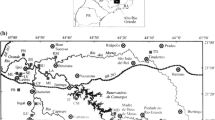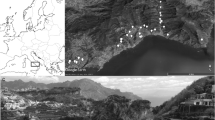Abstract
These days, human activities in the savanna and the remaining dry and riparian forests of the Sudanian ecoregions continue to have their impact. These anthropogenic practices are still the main cause of disturbances in these areas. In order to investigate and assess the importance of these disturbances, caused by people bordering on protected areas and to determine the relation between these activities and the environment in which they are carried out, 220 samples were selected in the three main protected areas of northern Togo. The investigation was mainly qualitative, considering the floristic sampling of this drought area; any anthropogenic activities observed were recorded. A simple investigative questionnaire about the activities of rural people in the reserved areas was distributed to individuals encountered in the study area. Each sample in the investigation ended with a site description of its ecological characterization, i.e., soil features, topography, fauna footprints, dominant plant species and GPS position; we also took photographs of the site. Data processing was entirely based on descriptive statistics and a factor analysis. The results show that eight kinds of human activities, i.e., the use of pastures, tree cutting, bush fires, charcoal production, harvesting of plant material, farming, honey harvesting and hunting, were noted to be serious disturbances to the integrity of the ecosystems. Among these disturbances, three are recurrent in all the sampled areas of which the use of pastures accounts for 31.88%, tree cutting for 30.35% and bush fires for 30.13%. Fire and pasture disturbances are closely linked and are responsible for the current features of the savanna area of the region. Tree cutting is more a direct function of the need for the production of wood fuel, generally used by city populations. Hunting, farming and honey production are of lesser importance in the area and therefore, do not pose a significantly negative effect on the growth of fauna and flora. Knowledge of these disturbances in the context of requalification and a renewed demarcation of protected areas in Togo is essential for their sustainable management.
Similar content being viewed by others
References
Adjonou K, Bellefontaine R, Kokou K. 2009. Les forêts claires du Parc national Oti-Kéran au Nord-Togo: structure, dynamique et impacts des modifications climatiques récentes. Sécheresse, 20(1e): e1–e10
Borozi W. 2007. Contribution à la gestion durable de la réserve de faune d’Aledjo, structure de la végétation, pression humaine et système de gestion. Mémoire de DEA, option: Gestion de l’Environnement. Universite de Lomé, Togo, 42 (in F rench)
Breininger D R, Nichols J D, Duncan B W, Stolen E D, Carter G M, Hunt D K, Drese J H. 2010. Multistate modeling of habitat dynamics: factors affecting Florida scrub transition probabilities. Ecology, 91(11): 3354–3364
Breman H, Kessler J J. 1995. Woody Plants in Agro-ecosystems of Semi-arid Regions: With an Emphasis on the Sahelian Countries. Advanced Series in Agricultural Science 23. Berlin, Heidelberg: Springer-Verlag, 340
Burkill H M. 1985. The Useful Plants of West Tropical Africa. Vol. 1. Families A-D. 2nd edn. Kew: Royal Botanic Gardens, 353–354
Collins M. 1990. Die Letzten Regenwälder. Berlin, Gütersloh, München, Stuttgart: RV Reise- und Verkehrsverlag, 199 (in German)
Dimobe K. 2009. Analyse de la dynamique spatiale des différentes formes de pressions anthropiques dans la réserve de l’Oti-Mandouri. Mem. DEA Biol.Veg. Appli. Univ. Lome, Togo, 61
Ern H. 1979. Die vegetatio Togos Gliederrung, gefährdung, erhaltung. Willdenowia, 9: 295–312 (in German)
Fousseni F, Kperkouma W, Zhang C Y, Zhao X H, Koffi A. 2011a. Woody vegetation of protected areas in northern Togo. Cases of Barkoissi, Galangashi and Oti-Keran: ecological and structure analyses of plant communities. Forest Stud China, 13(1), 23–35
Fousseni F, Samake G, Zhao C Y, Zhao X H, Kperkouma W, Komlan B, Koffi A. 2011a. Evaluation of agroforestry species in potential fallows of areas gazetted as protected areas in North-Togo. Afr J Agric Res, 6: 2828–2834
Garnier L K M, Dajoz I D. 2001. The influence of fire on the demography of a dominant grass species of West African savannas, Hyparrhenia diplandra. J Ecol, 89: 200–208
Jean-Louis D, Anne F. 1998. Écologie d’une savane africaine. Synthèse provisoire des résultats acquis. ORSTOM/ERMES, Orléans, France, 77 (in French)
Kaiser H F. 1960. The application of electronic computers to factor analysis. Educ Psychol Measure, 20, 141–151
MERF (Ministère de l’Environnement et des Ressources Forestières). 2003. Stratégie pour conservation des populations d’éléphants au Togo. Lomé, Togo, 40
Moussa A. 2008. Classification des climats en fonction de la végétation, des pluies et de la température. Dissertation for the Master Degree. Lomé, Togo: Université de Lomé, 181
Noëllie A Y. 2010. Mapping bushfire distribution and burn severity in West Africa using remote sensing observations. Dissertation for the Doctoral Degree. Würzburg, Germany: University of Julius-Maximilians, 137
Odion D C, Sarr D A. 2007. Managing disturbance regimes to maintain biodiversity in forested ecosystems of the Pacific Northwest. Forest Ecol Manage, 246: 57–65
Ofori B Y, Attuquayefio D K. 2010. Hunting intensity in the Suhuma Forest Reserve in the Sefwi Wiawso District of the Western Region of Ghana: A threat to biodiversity conservation. West Afr J Appl Ecol, 17: 135–142
Ouoba P. 2006. Flore et végétation de la forêt classée de Niangoloko,sud-ouest du Burkina Faso. Dissertation for the Doctoral Degree. Burkina Faso: Université de Ouagadougou, 140
Sankaran M, Ratnam J, Hanan N. 2008. Woody cover in African savannas: the role of resources, fire and herbivory. Global Ecol Biogeogr, 17: 236–245. DOI: 10.1111/j.1466-8238.2007.00360.x
Sessi K. 2001. L’étude prospective du secteur forestier en Afrique, FOSA/WP/40, Forestry Sector Outlook Studies (FAO), 28 (in French)
Sournia G, Alassoum O, Belemsobgo U, Djeri-Alassani B K, Lartiges A, Sinsin B, Thomassey J P. 1998. Les aires protégées d’Afrique francophone. Ed. ACCT/Jean-Pierre de Monza, 272 (in French)
Spottiswoode C N, Wondafrash M, Gabremichael M N, Dellelegn Abebe Y, Mwangi M A K, Collar N J, Dolman P M. 2009. Rangeland degradation is poised to cause Africa’s first recorded avian extinction. Anim Conserv, 12: 1–9. doi:10.1111/j.1469-1795.2009.00246
Trollope W S W, Trollope L A. 2004. Prescribed burning in African grasslands and savannas for wildlife management. Arid Lands Newsletter 55, Fire Ecology II
Trollope W S W, Trollope L A, Hartnett D C. 2002. Fire behaviour a key factor in the fire ecology of African grasslands and savannas. In: Viegas D X, ed. Forest Fire Research & Wildland Fire Safety. Rotterdam: Millpress
Turner M G. 2010. Disturbance and landscape dynamics in a changing world. Ecology, 91(10): 2833–2849
UICN/PACO. 2008. Evaluation de l’efficacité de la gestion des aires protégées: aires protégées du Togo. UICN, Gland, Switzerland and Cambridge, United Kingdom, 41 (in French)
White F. 1986. La végétation d’Afrique. Mémoire accompag nant la carte de végétation de l’Afrique. UNESCO/AETFA/UNSO (in French)
Yema E, Georges L, Association des Géographes Togolais. 1981. Atlas du Togo (Les Atlas Jeune Afrique). Paris: Éditions JA, 64
Yvon-Carmen H H. 2008. Dynamique environ nementale en zones sahélienne et soudanienne de l’Afrique de l’Ouest: Analyse des modifications et évaluation de la dégradation du couvert végétal. Dissertation for the Doctoral Degree. Belgique: Université de Liege, 153 (in French)
Author information
Authors and Affiliations
Corresponding author
Rights and permissions
About this article
Cite this article
Fousseni, F., Marra, D., Wala, K. et al. Assessment and impact of anthropogenic disturbances in protected areas of northern Togo. For. Stud. China 14, 216–223 (2012). https://doi.org/10.1007/s11632-012-0308-x
Received:
Accepted:
Published:
Issue Date:
DOI: https://doi.org/10.1007/s11632-012-0308-x




